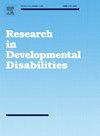Artificial intelligence-supported occupational therapy program on handwriting skills in children at risk for developmental coordination disorder: Randomized controlled trial
IF 2.6
2区 医学
Q1 EDUCATION, SPECIAL
引用次数: 0
Abstract
Aim
This study investigates the impact of an AI-supported occupational therapy program, developed using the Model of Human Occupation (MOHO), on handwriting skills in children at risk for Developmental Coordination Disorder (DCD).
Method
A randomized controlled trial was conducted with 42 children aged 8–12 years, identified as being at risk for DCD using the Developmental Coordination Disorder Questionnaire (DCDQ). Participants were randomized into an intervention group (n = 21) and a control group (n = 21). The intervention group received an AI-supported occupational therapy program twice weekly for 8 weeks. Handwriting performance was assessed pre- and post-intervention using the Minnesota Handwriting Assessment (MHA).
Results
Significant improvements were observed in the intervention group across all MHA subdomains, including writing speed, alignment, size, spacing, shape, and legibility (p < 0.001). The most pronounced improvements were in shape (d=2.279), alignment (d=1.893), and the total score (d=2.291). In contrast, the control group showed minimal changes, with significant improvement observed only in alignment (p = 0.006; d=0.311). Between-group comparisons demonstrated superior performance in the intervention group across all subdomains (p < 0.05).
Conclusion
This study highlights the transformative potential of AI-supported occupational therapy programs in addressing the multifaceted challenges of handwriting rehabilitation in children at risk for DCD.
人工智能支持的职业治疗计划对发育协调障碍高危儿童手写技能的影响:随机对照试验
目的本研究调查了人工智能支持的职业治疗项目,该项目使用人类职业模型(MOHO)开发,对有发育性协调障碍(DCD)风险儿童的书写技能产生的影响。方法采用发育协调障碍问卷(DCDQ)对42名8-12岁儿童进行随机对照试验。参与者被随机分为干预组(n = 21)和对照组(n = 21)。干预组接受人工智能支持的职业治疗方案,每周2次,持续8周。使用明尼苏达笔迹评估(MHA)评估干预前和干预后的笔迹表现。结果干预组在所有MHA子域均观察到显著改善,包括书写速度、对齐、大小、间距、形状和易读性(p <; 0.001)。最显著的改善是形状(d=2.279)、对齐(d=1.893)和总分(d=2.291)。相比之下,对照组的变化很小,仅在对齐方面有显著改善(p = 0.006;d = 0.311)。组间比较表明,干预组在所有子领域的表现都优于干预组(p <; 0.05)。本研究强调了人工智能支持的职业治疗项目在解决DCD风险儿童书写康复的多方面挑战方面的变革潜力。
本文章由计算机程序翻译,如有差异,请以英文原文为准。
求助全文
约1分钟内获得全文
求助全文
来源期刊

Research in Developmental Disabilities
Multiple-
CiteScore
5.50
自引率
6.50%
发文量
178
期刊介绍:
Research In Developmental Disabilities is aimed at publishing original research of an interdisciplinary nature that has a direct bearing on the remediation of problems associated with developmental disabilities. Manuscripts will be solicited throughout the world. Articles will be primarily empirical studies, although an occasional position paper or review will be accepted. The aim of the journal will be to publish articles on all aspects of research with the developmentally disabled, with any methodologically sound approach being acceptable.
 求助内容:
求助内容: 应助结果提醒方式:
应助结果提醒方式:


